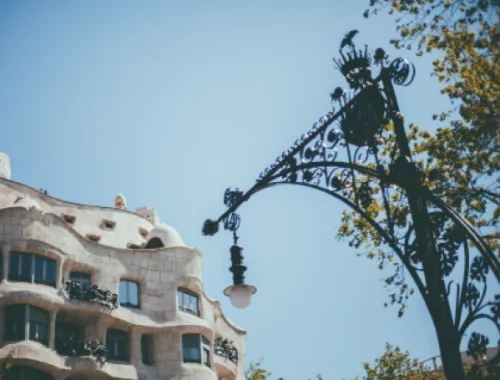When the walls erected by the Bourbons around the old city were finally demolished in 1854, the Catalan cultural rebirth began to strengthen and felt the need to expand the city. When the new district was planned, there was declared an architectural tender and the winner was Ravira – an architect from Barcelona. However, the Madrid government disregarded the results of the tender and the chief architect Ildefons Cerdá was appointed. His idea was to create a city-garden with squares based on perpendicular one-way streets and with the interior court of each quarter that its residents could spend leisure time there. He considered absolutely all the factors: solar lighting, ventilation, transport. The chamfered corners of houses are not a whim of the architect, but a practical decision, with the aim to improve traffic and visibility of the side streets and widen the cross-road.
Even with a significant increase in the traffic from the middle of the XIX century, Eixample is extremely easy to navigate. The average height of residential buildings is 5-6 floors. But they are fabulous: the ceilings in the apartments reach three meters height, rooms are equipped with arched shutters and forged balconies and the elevators made in the XIX-th century are incredible adventure – they usually have internal shutters and external grille, and you must be very carefully closing it, otherwise the elevator will not move. If you look for the names of streets of Eixample in the encyclopaedia, you will have a little tutorial on the history of the Catalan heritage. Thus, the Consell de Cent refers to “Council of One Hundred” – the governmental institution of Barcelona from XIII to XVIII century. A dozen of other streets remember us the friendly territories of the former Crown of Aragon: Aragó, Valencia, Sicilia, Cerdeña, Nápoles…
Since 1890 the Catalan bourgeoisie chose this area to built the most beautiful houses. Thus Eixample became a better architectural ensemble of Art Nouveau, the most luxurious and the most colourful in the city.

Now Eixample consists of five neighbourhoods.
Passeig de Gracia is an elegant and majestic avenue that was a showcase of the bourgeois Barcelona of the XIX century. It connects Plaça Catalunya and the Gracia district and divides Eixample into right and left part. There are many boutiques of the world famous brands, two houses of Gaudí – famous Casa Batlló and La Pedrera, as well as other architectural masterpieces. The most popular quarter is “Quarter of disagreement”, which got its name, because its main buildings are completely visually incompatible and create a kind of stylistic contrast. Last year the city government upgraded Passeig de Gracia by setting eight “intelligent” bus stops throughout its length. Each one is equipped with a tactile screen so the passengers can use applications of social services or, for example, find out the location of favourite brand store. Any other information they can find using free Wi-Fi.

Eixample Derecha is the right side of the district that starts in Plaça Catalunya – the essential link between medieval Barcelona and the new city – is built around Passeig de Gràcia. Mainly middle class lives here. It reflects the rise of Modernism with buildings such as Casa Batlló and Casa Milà. Its commercial and tourist appeal means it is still one of the city’s central hubs today.
Eixample Izquierda is the left-hand side, reaches Plaça d´Espanya and Tarragona Street in the west and noisy Balmes Street in the east. And Urgell Street divides it into “old” and “new” parts.
The “old” part of Eixample Izquierda is not so showy as Eixample Derecha, but it has other attractions. It is quiet residential area where you can find a beautiful building of University of Barcelona, Hospital Clínic and Medical Faculty. The “new” part of Eixample Izquierda is located between the ancient factory Can Batlló, which was turned into the Industrial School, and Joan Miró park where previously had been Slaughterhouse.
In the north of “new” Eixample Izquierda there is Sant Antoni neighbourhood where predominates young and modern generation. Is has trading environment created by the famous market of Sant Antoni, Moritz beer factory and a wide variety of shops.
Sagrada Familia is a little bit away from the centre which spreads out round the monumental church of the architect Antonio Gaudí. Life in this neighbourhood goes on peacefully, its streets are full of shops and small businesses and people who have lived there all their lives. It has many modernist buildings and an abundance of parks.
Fort Pienc, which lies between Avenida Diagonal, Avenida Meridiana and Passeig de Sant Joan, is a neighbourhood with full of life avenues and many green spaces for doing sport or relaxing in.
Eixample wins from the other districts of Barcelona with the quantity of important factors for the comfortable life, but it still falls short of parks and gardens. The Barcelona’s visitors can feel the deficit of green areas where they can spend some time with children. But when Barcelona won the right to host the Summer Olympic Games in 1992, the city has turned into a giant construction site and one of the important questions raised in the agenda was the reorganization of the inner courtyards of the Eixample district. And in the late 80s appeared small inner gardens that received a special name Jardins d’interior d’illa. People call these gardens “hidden” or “secret”, because not everybody can guess that somewhere at the end of a narrow passage there is a light and cozy park.
Taking all the above mentioned into account we can say that Eixample is not just a good district, but it is good in all senses.





